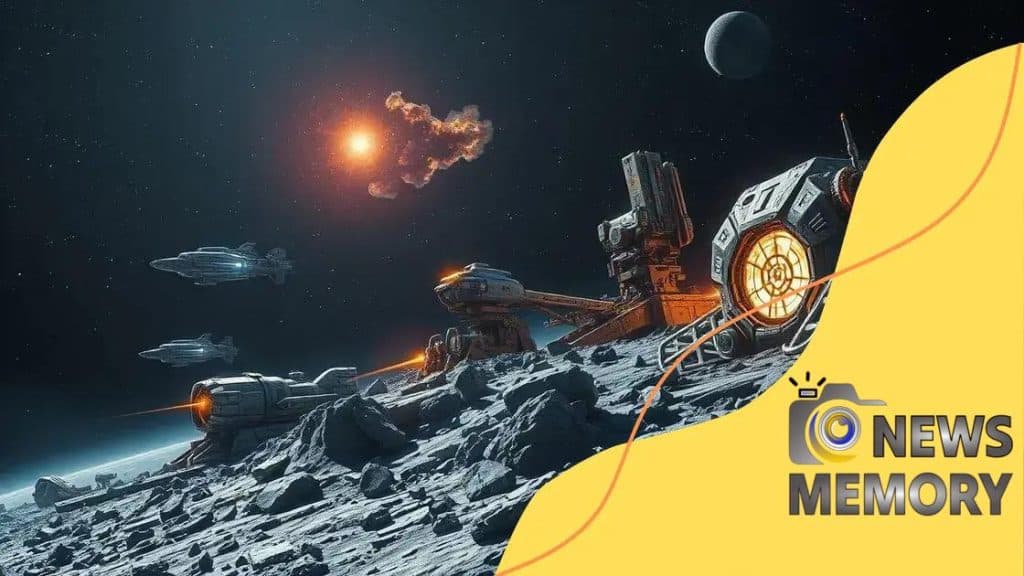The future of space mining and its economic potential

The future of space mining involves extracting resources like water and precious metals from asteroids, with significant technological advancements and collaboration between private companies and governments driving the industry.
The future of space mining and its economic potential invites us to imagine a world where resources from asteroids could power our economies. Have you ever thought about how tapping into these extraterrestrial reserves might impact our lives and industries?
Understanding space mining and its technologies
Understanding space mining and its technologies opens up a fascinating world where resource extraction is not just limited to Earth. With advancements in technology, we are now on the brink of exploring asteroids and other celestial bodies for valuable materials.
The first step in this journey involves understanding what space mining entails. It refers to the extraction of resources like metals and minerals from asteroids, moons, and planets. These resources could provide raw materials for various industries on Earth and potentially sustain future human settlements in space.
Key Technologies in Space Mining
Several technologies are being developed to facilitate space mining operations. These include:
- Robotic Systems: Robots will play a crucial role in exploring and mining asteroids.
- Advanced Propulsion: Efficient propulsion systems are needed to reach and navigate the mining sites.
- Mining Equipment: Specialized tools will be designed to extract resources effectively in low-gravity environments.
In addition to these, the use of AI and autonomous systems will greatly enhance mining efficiency. With AI, we can analyze vast amounts of data to identify rich mining sites, and autonomous systems can operate machinery without human intervention.
The Role of Robotics
Robotic systems are essential in making space mining a reality. These machines can function in the harsh environments of space where human survival is challenging. From drilling into the surface of asteroids to transporting mined materials, robots can handle numerous tasks with precision.
As technology improves, these robots will become more sophisticated and capable of performing complex operations. The combination of robotics and AI will lead to incredible advancements in the mining process, reducing the risks involved in the operations.
Overall, understanding space mining and its technologies is crucial as we prepare for the next frontier of resource exploration. With advancements in robotics, AI, and mining equipment, the potential for extracting valuable materials from space becomes increasingly feasible.
Key resources targeted in space mining
Key resources targeted in space mining are critical to understanding the economic potential of extracting materials from asteroids and celestial bodies. This venture could reshape our economy by providing essential materials that are scarce on Earth.
One major resource is water, which can be found on the Moon and certain asteroids. This ice can be used for drinking, but more importantly, it can be converted into hydrogen and oxygen for fuel, enabling further space exploration.
Valuable Metals
Another key target in space mining includes valuable metals like gold, platinum, and rare earth elements. These metals are crucial for technology production and have increasing demand across various industries.
- Gold: Known for its value and electrical conductivity, it’s essential in electronics.
- Platinum: Used in catalytic converters, and its scarcity makes it highly valuable.
- Rare Earth Elements: Vital for manufacturing modern electronics, including smartphones and electric vehicles.
Additionally, asteroids are believed to contain other resources like nickel and iron. These materials can support manufacturing processes and contribute to the construction of spacecraft.
The Role of Asteroids
The composition of asteroids varies widely, making them exciting targets for space mining. For instance, carbonaceous asteroids are rich in organic compounds, while metallic asteroids are composed mainly of metals. Each type offers unique extraction opportunities.
Mining these asteroids involves identifying the rich ones with the right resources. This requires advanced technology and strategies to extract materials safely and efficiently. The potential yield from these resources could support not just space ventures, but also consumer goods back on Earth.
In summary, as we explore space mining, the focus on key resources like water, metals, and rare earth elements reveals a promising future. The ability to tap into these valuable commodities could revolutionize industries and expand human presence beyond Earth.
Economic implications of space mining for Earth

Economic implications of space mining for Earth are vast and could reshape global markets and industries. As we learn to tap into the resources of asteroids and other celestial bodies, we stand on the brink of a resource revolution.
One major impact will be the availability of new materials. If space mining can deliver precious metals and resources back to Earth, it could decrease the dependence on terrestrial mining. This shift might help to stabilize prices of metals like gold and platinum.
Job Creation
Additionally, space mining can create numerous jobs. As new industries rise to support mining operations in space, many roles will be needed, from engineers to robotic operators. The global job market could see significant growth in high-tech fields.
- Engineering Positions: Developing mining technologies will need skilled engineers.
- Operations Personnel: Trained teams will manage and operate machinery and robotics.
- Research and Development: Scientists will be required to innovate and improve extraction methods.
This growth wouldn’t only be limited to the mining sector; support industries, such as transportation and logistics, will also expand to handle the shipping of resources from space.
Market Disruptions
The arrival of resources from space could disrupt current markets. For instance, if large amounts of platinum were to be mined from asteroids, the sudden increase in supply could reduce prices significantly. While this might be beneficial for industries relying on these resources, it could harm current mining operations and economies in countries dependent on terrestrial mining revenues.
Moreover, the sustainability aspect of mining asteroids should not be overlooked. Space mining could preserve Earth’s environment by reducing the need for destructive mining practices on land. As we focus on sustainability, space mining provides an opportunity to mitigate ecological damage.
In conclusion, the economic implications of space mining for Earth are profound. From creating new job opportunities to potentially stabilizing or disrupting markets, the impacts will reverberate through economies globally.
Challenges facing the space mining industry
Challenges facing the space mining industry are significant and multifaceted. As we venture into this exciting new frontier, understanding these challenges is crucial for success.
One major challenge is the high cost of space missions. Launching spacecraft requires advanced technology and a substantial budget. Developing the necessary equipment and ensuring its reliability can be prohibitively expensive. This financial barrier poses risks for companies looking to invest in space mining.
Technical Difficulties
Technical difficulties also present obstacles. Mining in space requires innovations in robotics, communication, and resource extraction methods. Equipment must operate reliably in extreme conditions, including radiation and zero gravity. The current technology may not be sufficient to carry out operations efficiently.
- Robotic Limitations: Robotic systems need to be advanced enough to perform complex tasks autonomously.
- Communication Delays: Signal delays between Earth and space can hinder real-time operations and adjustments.
- Environmental Hazards: Mining equipment must withstand harsh environments, including temperature fluctuations and micrometeorites.
Another challenge is the legal and regulatory landscape around space mining. International treaties like the Outer Space Treaty complicate ownership and resource rights. Clear guidelines and agreements between countries and companies are necessary to ensure fair practices.
Environmental Concerns
Environmental concerns also play a role in shaping the space mining industry. Extracting resources in space should be done responsibly to prevent potential contamination of celestial bodies. Sustainable mining practices must be developed to minimize the impact on ecosystems beyond Earth.
As we look to the future of space mining, addressing these challenges is crucial for establishing a viable industry. Companies will need to innovate, collaborate, and strategize to overcome the hurdles that lie ahead.
Future trends in space exploration and mining
Future trends in space exploration and mining hold exciting possibilities as technology continues to advance. The momentum gained in recent years suggests that we are on the verge of significant breakthroughs in accessing and utilizing extraterrestrial resources.
One prominent trend is the increasing collaboration between private companies and governments. Space agencies, like NASA, are partnering with private firms to leverage their innovative technologies and funding. This partnership aims to accelerate the development of missions focused on space mining.
Technological Advancements
As we look to the future, several technological advancements will shape the space mining industry. Robotics is set to play a central role, with improved autonomous robots designed for resource extraction. These machines will be crucial for performing tasks safely in harsh environments.
- Artificial Intelligence: AI will enhance decision-making processes, allowing machines to make real-time adjustments during mining operations.
- Advanced Propulsion Systems: More efficient propulsion technologies will reduce travel time to mining sites, making operations more feasible.
- 3D Printing: Utilizing materials found during mining could enable on-site construction of tools and necessary infrastructure.
Another trend is the exploration of asteroids rich in valuable resources. Missions targeting near-Earth asteroids are already being planned. These asteroids are ideal candidates for mining, as they may contain metals like gold and platinum as well as water, which can be used to support future missions.
Focus on Sustainability
Sustainability is becoming a priority in space mining practices. As interest in space mining grows, there will be a greater emphasis on ensuring that these activities do not harm celestial bodies or create debris. Establishing responsible mining methods and regulations will be essential to maintain the integrity of space environments.
Ultimately, the future of space exploration and mining relies on innovation and responsible practices. With technology advancing at a rapid pace, our ability to harness extraterrestrial resources could redefine industries on Earth and support humanity’s expansion into the cosmos.
FAQ – Frequently Asked Questions About Space Mining
What is space mining?
Space mining refers to the extraction of valuable resources from asteroids, moons, and other celestial bodies for use on Earth and in space exploration.
What resources can be mined in space?
Key resources include water, precious metals like gold and platinum, and rare earth elements, which are essential for technology and manufacturing.
What are the main challenges of space mining?
Challenges include high costs, technical difficulties, legal and regulatory issues, and the need for sustainable practices to protect space environments.
How will space mining impact the economy?
Space mining has the potential to create jobs, stabilize prices for certain metals, and provide new materials that could transform industries on Earth.





